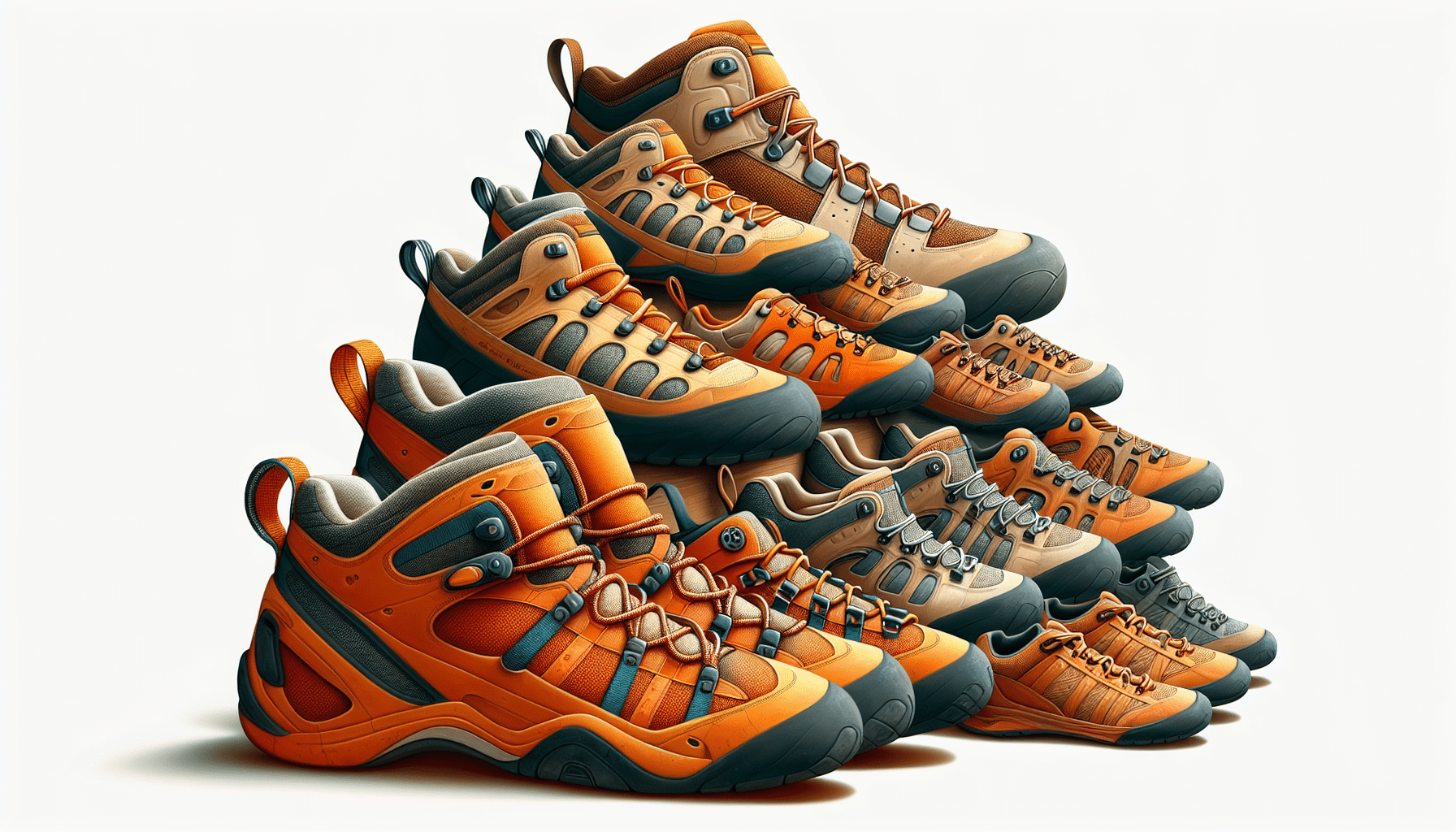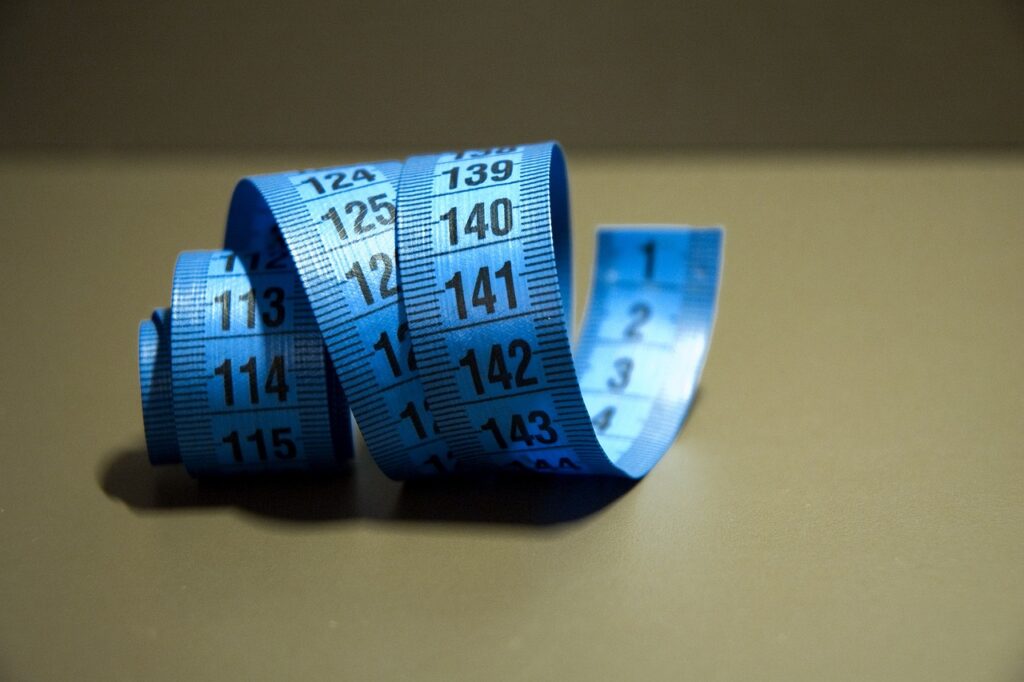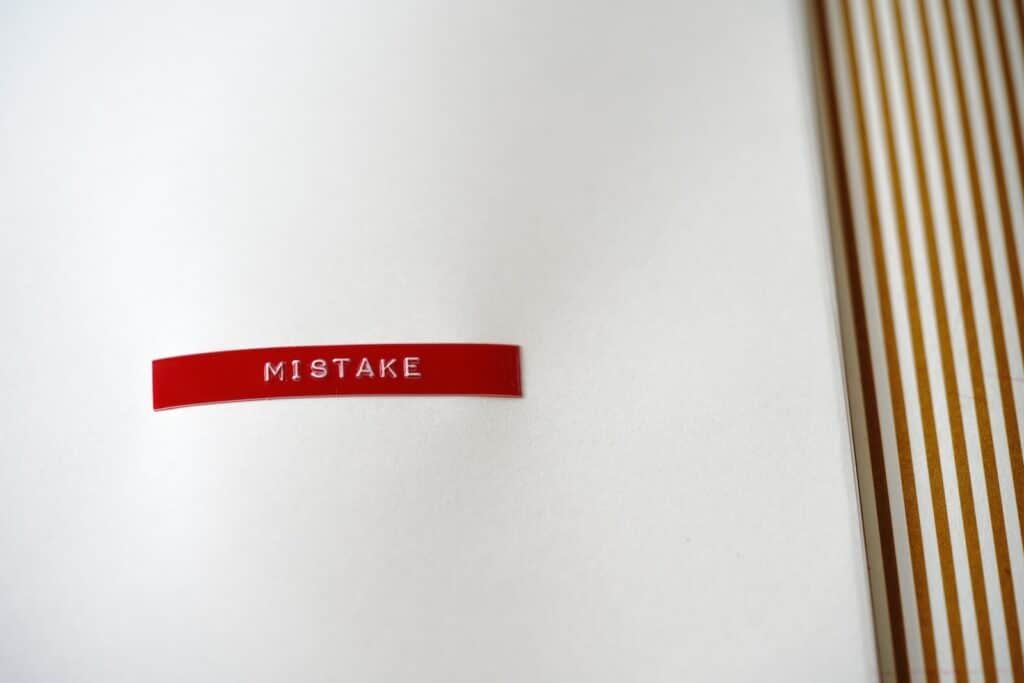Table of Contents
ToggleUnderstanding Climbing Shoe Sizing
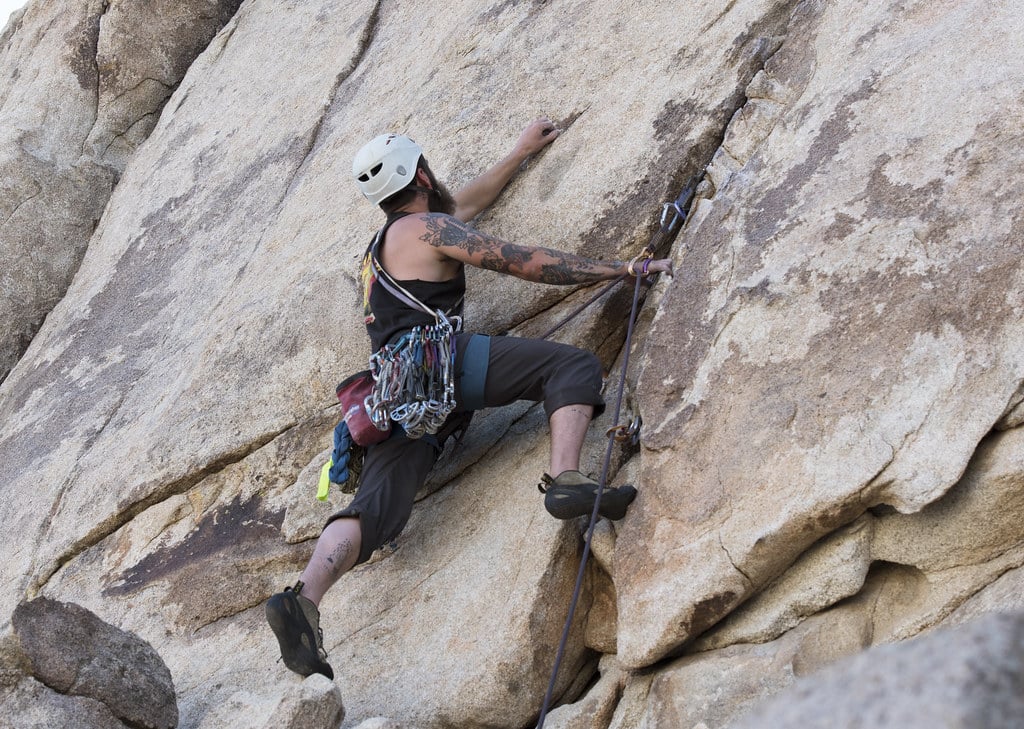
When it comes to rock climbing, I can’t emphasize enough how crucial it is to get your climbing shoe sizing right. Trust me, it’s not just about comfort, but it can significantly influence your performance and safety too!
Why Climbing Shoe Sizing Matters
Climbing shoe sizing is a big deal! It’s like the secret sauce to mastering those tricky routes and boulders. A well-fitted climbing shoe can provide the precise control and sensitivity you need to feel the rock and execute those technical moves like a pro.
On the other hand, shoes that are too large can leave you feeling unsteady and insecure on small holds, while ones that are too tight can cause discomfort and even pain. So, you see, finding the right size is not just about comfort, but it’s also about maximizing your climbing potential.
The Difference Between Brands
Here’s the tricky part. You’d think that once you know your shoe size, you’re good to go. But hold on! When it comes to climbing shoes, it’s not that simple. Climbing shoe sizes can vary between different brands and models, so it’s important to try on multiple pairs to find the best fit for you (Climbing Shoe Review).
It’s just like how a size 9 in Nike might not fit the same as a size 9 in Adidas. Similarly, a size 43 in Brand A might feel entirely different than a size 43 in Brand B.
So my advice? Experiment, experiment, experiment! Try on different climbing shoe brands and multiple sizes to find the perfect fit for your foot shape and climbing style.
Remember this golden rule: there’s no universal “best” when it comes to climbing shoes. The best climbing shoes are the ones that fit your feet perfectly and suit your climbing style. So, take the time to understand your climbing shoe sizing thoroughly, and you’ll be well on your way to conquering those crags!
Finding the Perfect Fit
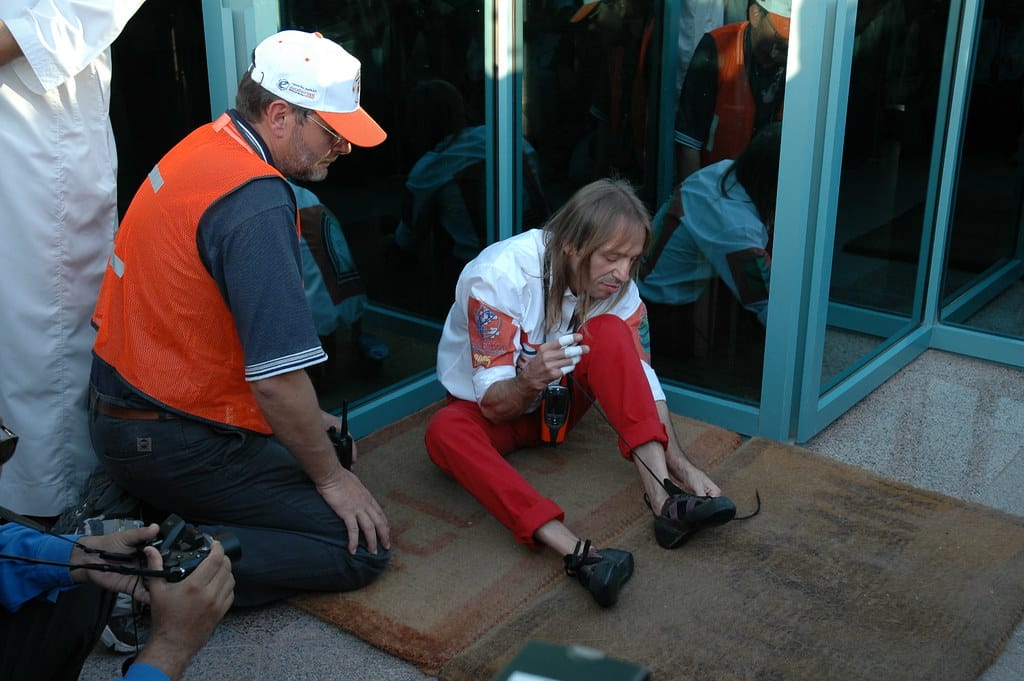
When it comes to climbing shoe sizing, perfecting the fit is crucial. This isn’t about squeezing into the smallest size possible, but rather finding a balance between comfort and function for optimized performance.
The Snug Fit Principle
Climbing shoes should fit you like a second skin. It should be snug, but not painfully tight. You might initially find them uncomfortable, but they will stretch and mold to your feet over time. Remember, the goal is to minimize movement inside the shoe for better sensitivity and control while climbing.
It’s also worth noting that climbing shoes made of leather tend to stretch over time. So, it’s recommended to choose a size that is comfortably snug, but not too tight.
Toe and Heel Considerations
The ideal climbing shoe will have your toes slightly curled, but not painfully crunched or curled over the edge of the shoe. This is known as the ‘asymmetric’ fit, and it is designed for precision on the rock. If you’re curious about this, check out our page on climbing shoe asymmetry.
The heel of your climbing shoe should also fit securely. Any excessive movement can compromise your control and balance. It’s important to remember that climbing shoes aren’t meant to fit like regular shoes. They’re designed to maximize your ability to grip and feel the rock (Climbing Shoe Review).
When it comes to climbing shoe sizing, it’s important to note that a shoe that’s too big can decrease performance and make it harder to maintain your grip on holds. So, while it might be tempting to size up for comfort, remember that a tighter fitting shoe will provide better sensitivity and control.
By keeping these factors in mind, you’ll be well on your way to finding the perfect pair of climbing shoes for your next climb. Remember, everyone’s feet are different and what works for one person may not work for you. So, take your time, try on different styles and brands, and find the shoe that feels best for you. Happy climbing!
Climbing Styles and Shoe Sizes
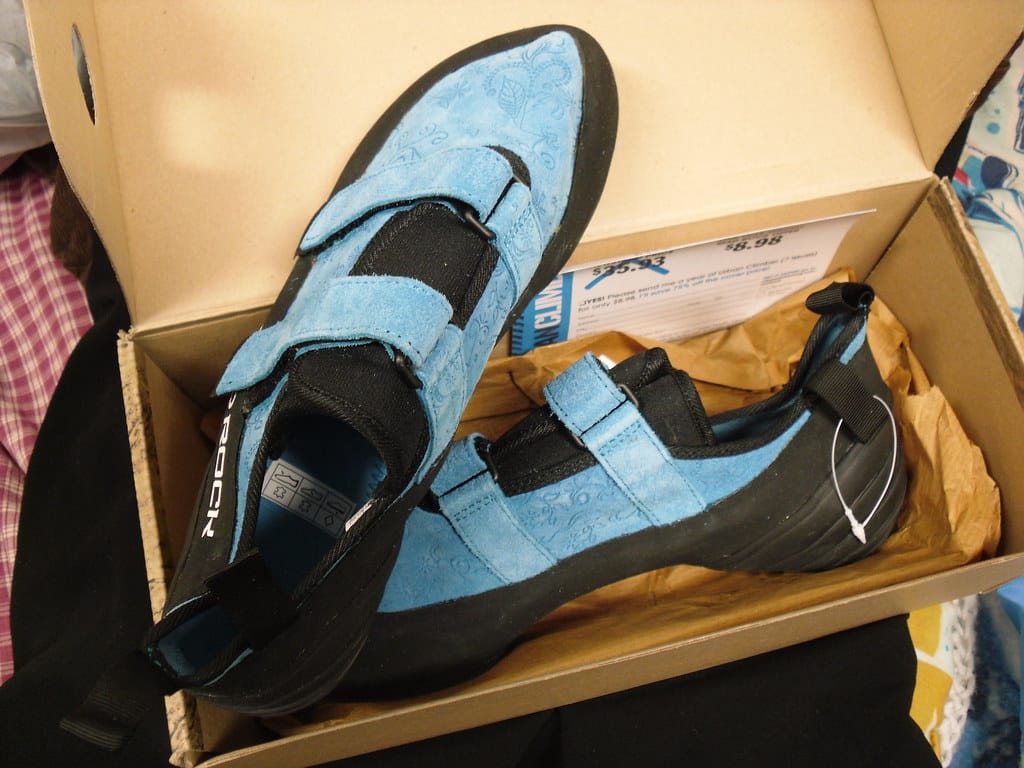
The world of rock climbing is as diverse as the shoes designed for it! Depending on the type of climbing you’ll be embarking on, different fits could serve you better. It’s also a balancing act between comfort and performance! Let’s dive into more detail.
Different Climbing Types, Different Fits
Every style of climbing calls for a particular type of shoe. Whether you’re bouldering, sport climbing, or tackling long multi-pitch routes, each style demands a different type of grip, precision, and comfort.
Bouldering, for instance, typically requires more aggressive shoes. This means the shoes are downturned and fit tighter, providing more precision on small footholds and overhangs. If you’re more into long multi-pitch routes, you might prefer a more relaxed or neutral fit for comfort during those long hours on the wall.
Shoes should fit snugly, without any painful pressure points or gaps. It’s normal for climbing shoes to feel tight at first, but they should become more comfortable as they break in. Also, keep in mind that your foot should have minimal movement inside the shoe. This helps with precision and control while climbing.
Performance vs. Comfort
Here’s the fun part! Choosing between performance and comfort can be quite the dance. A tighter shoe usually offers better performance, but at the expense of comfort (Climbing Shoe Review). So, it’s all about finding that sweet spot between a snug fit that gives you control and a shoe that won’t make you wince in pain with every step.
Most climbers find a middle ground, where their shoes are snug for optimal performance, but not too tight that they can’t stand wearing them for longer periods. The most important factor in climbing shoe sizing is personal comfort. While a more performance-oriented climber might prefer a tighter fit, others may prioritize a more relaxed fit for longer sessions (Climbing.com).
Remember, no amount of performance is worth risking your foot health over! Always listen to your body and choose shoes that will support your climbing without causing unnecessary discomfort.
So, you see, climbing shoe sizing isn’t just about the numbers. It’s about the fit, the feel, and how it aligns with your climbing style. Happy climbing, and don’t forget to check our other articles on climbing shoe technology and climbing shoe care for more tips and advice!
Material and Sizing
The material of climbing shoes significantly affects their fit, comfort, and stretch. As a climbing beginner, you’ll commonly come across two types of materials: leather and synthetic.
Leather vs. Synthetic Materials
Let’s talk about leather first. Leather climbing shoes are known for their comfort and durability. They mold to your feet over time, providing you with a custom-like fit. According to La Sportiva, leather shoes tend to stretch, so it’s recommended to choose a size that is comfortably snug, but not too tight. If you’re interested in how different materials affect climbing shoe technology, check out our article on climbing shoe technology.
On the other hand, synthetic climbing shoes are known for their ability to maintain their shape and size over time. This means they won’t stretch as much as leather shoes. So, when you’re trying on synthetic shoes, make sure they fit just right from the start.
| Material | Stretch | Fit |
|---|---|---|
| Leather | Stretches over time | Choose a snug fit |
| Synthetic | Minimal stretch | Choose a perfect fit from the start |
Stretching and Break-in Period
Regardless of the material, all climbing shoes will have a break-in period. This is the time it takes for the shoes to mold to the shape of your feet. During this period, your shoes may stretch and become more comfortable. This is especially true for leather shoes, which tend to stretch more than synthetic ones.
However, it’s important to remember that, while some stretching is expected, your climbing shoes should never be painfully tight. If they are, you may have chosen a size too small. On the other hand, if your shoes are too loose, they may not provide the precision and control you need for climbing.
Finding the right climbing shoe sizing is like striking a balance. It might seem tricky at first, but with a little patience and guidance, I’m confident you’ll find your perfect fit. Remember, no matter what material or size you choose, your shoes should always feel snug but not painful. Happy climbing!
Size Conversion and Measurement
Alright, now that we’ve got the basics of climbing shoe sizing down, let’s dive into size conversion and when it’s best to try on shoes!
From US to European Sizes
Now, here comes the fun part. Climbing shoe sizes are typically measured in US sizing, European sizing, or a combination of both. And, let me tell you, it’s not always a straightforward conversion. Climbing shoe sizing can vary between different brands and models, so it’s important to try on different brands and models to find the best fit.
| US Men’s | US Women’s | European |
|---|---|---|
| 6 | 7.5 | 38 |
| 6.5 | 8 | 39 |
| 7 | 8.5 | 39.5 |
| 7.5 | 9 | 40 |
| 8 | 9.5 | 41 |
| 8.5 | 10 | 41.5 |
This table shows a general conversion between US and European sizes, but remember, the best fit might not always stick to this chart. For more details on different brands, check out our climbing shoe brands guide.
Trying Shoes in the Afternoon
Ready to go try on shoes? Great! Here’s a pro tip: Your feet can swell during the day, especially if you’ve been walking around or climbing. So, the best time to try on climbing shoes is in the afternoon to get the most accurate fit (La Sportiva).
When trying on shoes, don’t forget to wear the same type of socks you plan to climb in. And remember, you’re looking for a snug fit, not painful. So take your time, try a few pairs, and don’t rush – your feet will thank you!
Now that you’ve got the lowdown on climbing shoe sizing and measurement, you’re one step closer to finding the perfect pair of climbing shoes. Happy climbing!
Common Mistakes in Sizing
As exciting as it is to grab your first pair of climbing shoes, it’s critical to get the sizing right. Many beginners tend to make some common mistakes while sizing their climbing shoes. So, let’s dive into the two biggest slip-ups: oversizing and undersizing issues, and neglecting comfort over performance.
Oversizing and Undersizing Issues
Whether it’s the thrill of starting a new sport or the excitement of getting new gear, many of us might rush into buying our first pair of climbing shoes without proper sizing. And, it’s a mistake I’ve seen happen time and again.
It’s important to understand that climbing shoes should fit snugly, but not be painfully tight. They should feel like a second skin on your feet. The shoes should be tight enough to minimize movement inside the shoe, allowing for better performance and control while climbing.
An oversized shoe might feel more comfortable initially, but it can lead to reduced control and precision. On the flip side, an undersized shoe can cause discomfort and potential injury.
Neglecting Comfort Over Performance
Climbing shoes should provide a secure fit, with minimal movement of the foot inside the shoe. But remember, a secure fit does not mean compromising on comfort.
Some climbers might be tempted to opt for a smaller size for better performance. However, a shoe that’s too tight can cause discomfort, pain, and even potential injuries. It’s essential not to neglect comfort over performance.
A well-fitted climbing shoe should be snug around the heel and midfoot, with minimal movement or slipping.
Getting the right climbing shoe sizing is essential for both your climbing performance and foot health. So, take your time, do your research, and don’t rush the process. For more tips and tricks on choosing the right climbing shoes, check out our article on climbing shoe performance.
Expert Advice on Climbing Shoe Sizing
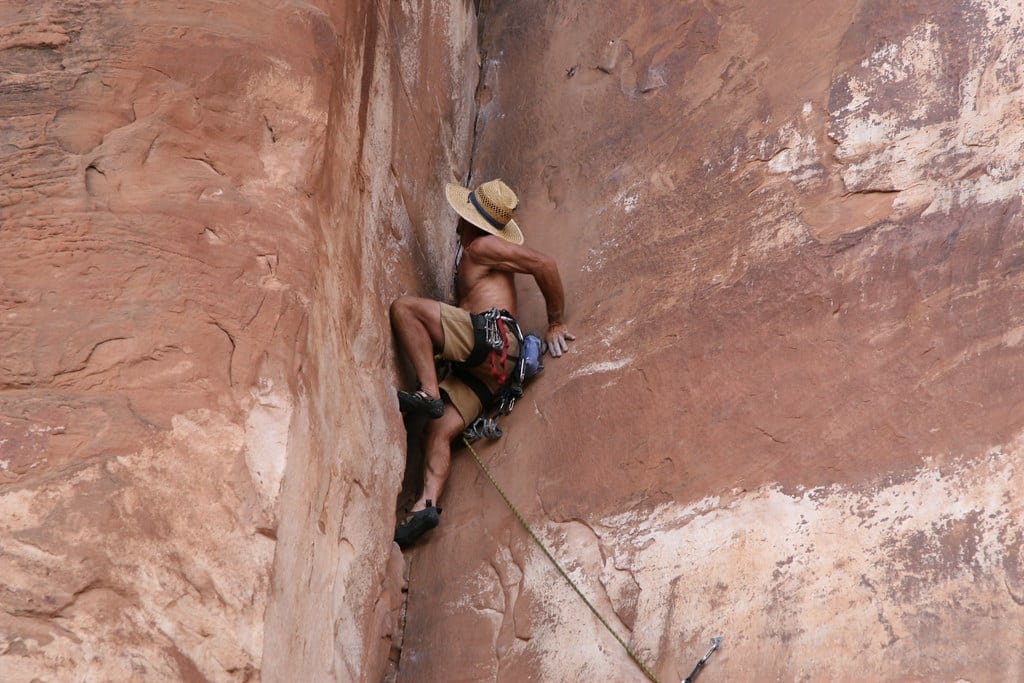
Remember how I said that climbing shoe sizing can be a bit tricky? Well, that’s why we’re going to dive into some expert advice to help you navigate the process. There’s so much to learn from professionals and experienced climbers – let’s get started!
Consulting with Professionals
When it comes to finding that perfect fit, you don’t need to go it alone. In fact, it’s highly recommended to consult with experienced climbers or climbing shoe specialists to get personalized advice on sizing and fit (Climbing Shoe Review). These professionals have the knowledge and experience to guide you towards the best shoes for your climbing needs!
It’s also important to check out the specific sizing recommendations provided by each shoe manufacturer. They’ve got their own unique sizing systems, so it’s a good idea to see what they suggest. Don’t be shy about asking for help in a store or reaching out to the manufacturer directly – they’re there to help you!
Learning from Experienced Climbers
Experienced climbers have been in your shoes (pun intended!) and have valuable insights to share. They can provide real-world advice on what worked for them and what didn’t when it comes to climbing shoe sizing.
Remember, climbing shoe sizes can vary between different brands and models, so don’t be afraid to try on multiple pairs to find the best fit for you. What fits one person perfectly might not work as well for you, so keep an open mind and be patient in your search.
Also, don’t forget to tap into the wealth of knowledge available in the climbing community. Join local climbing clubs, participate in online forums, and read climbing shoe reviews to learn from others’ experiences.
Choosing your first pair of climbing shoes is an exciting step in your climbing journey. With a little help from professionals and the climbing community, you’ll find the perfect fit in no time! So get out there, and start exploring the wonderful world of climbing shoes!

